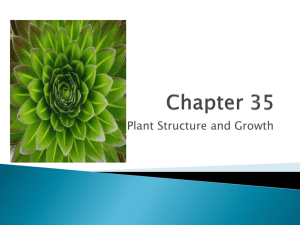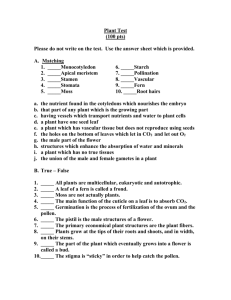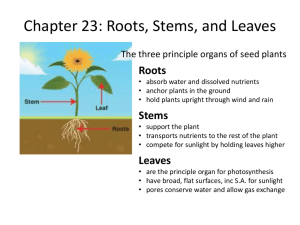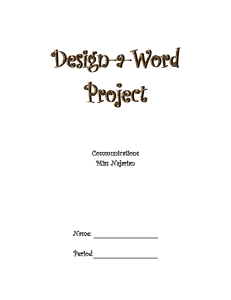Plant Unit: part 2
advertisement
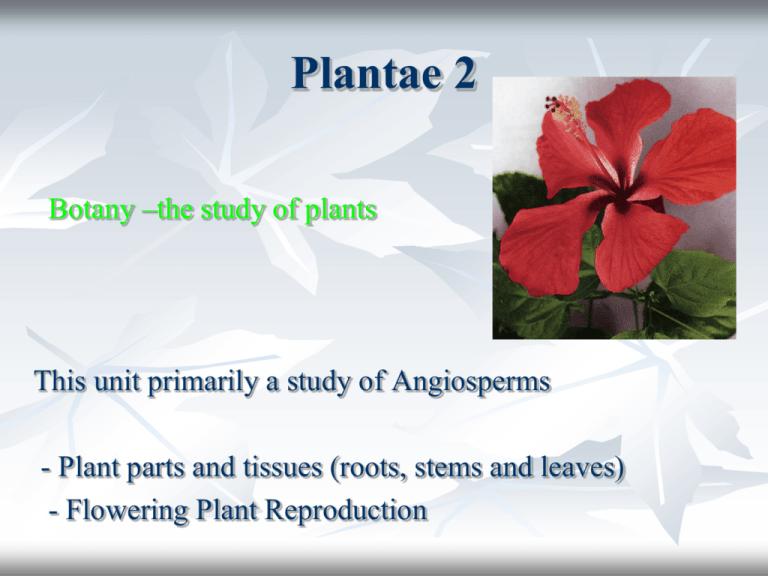
Plantae 2 Botany –the study of plants This unit primarily a study of Angiosperms - Plant parts and tissues (roots, stems and leaves) - Flowering Plant Reproduction Meristematic Tissue Unlike animals, plants only divide in specific areas called meristems Meristems found at the tips of roots and stems are called apical meristems and produce the most rapid growth Root and stem lengthening is called primary growth More Meristematic Tissue Cork cambium produces the outer covering of stems Vascular cambium produces vascular tissue and increases the thickness of stems over time. Pericycle enables roots to grow thicker and makes it possible for roots to branch Secondary growth is the increase in diameter Most herbaceous monocots don’t experience secondary growth while all woody plants do Plant Tissue Types Plant cells differentiate into three kinds of tissue : epidermal, vascular and ground There are also three main types of cells used to make these tissues Parenchyma is the thin walled cell found throughout a plant Sclerenchyma cells have tough thick walls and are used to strengthen and support plant tissues Collenchyma is mainly a developmental support cell and we won’t address it in this unit Epidermal tissue Epidermal tissue, like the skin on us, protects plants from parasites and from water loss, except in the roots were it facilitates water entry. Tightly packed epidermal cells Vascular Tissue Vascular tissues include xylem and phloem Xylem consists of tracheids and vessel elements (usually dead when mature) Phloem cells are called sieve tube members ( alive when mature, no nucleus) Ground tissue Ground tissue is usually made up of parenchyma. When found at the center of roots and stems it’s called pith. Important functions of ground tissue is to support vascular tissue and store food and water. CS of stem Roots, Stems and Leaves Sun Energy 6CO2 + H2O C6H12O6 + 6O2 Every developmental adaptation of roots, stems and leaves is a slave to this formula. Roots gather water, stems hold up leaves to the sun that have adapted to take in carbon dioxide to produce the energy the rest of us need to live. Roots Anchor the plant Absorb water and minerals from the soil Store food that is produced in the leaves Two types : fibrous and taproot Roots Roots are composed of three structures : epidermis, cortex and vascular cylinder Roots The epidermis contains root hairs which greatly increase the surface area of the root system and increase the plants capacity to absorb water Roots The cortex is mostly parenchyma with an inside layer of endodermis that controls water flow into the vascular cylinder using active transport of minerals Vascular Cylinder Monocots and Dicot roots have different vascular cylinders MONOCOT DICOT Stems Stems transport food, water, and minerals between the roots and leaves and support plant growth above ground, exposing leaves to the sun. Stems have four types of tissue : Parenchyma (pith), vascular, cambium (vascular and cork), and cork tissue (bark) The arrangement of vascular tissue differs between monocots and dicots Herbaceous stems- with little or no secondary growth these stems are partially supported by turgor pressure, the pressure of water in the vacuoles. Woody stems exhibit secondary growth adding another ring of xylem each year Leaves Leaves are the original solar collectors They need sun, water and CO2 to make our food and so they maximize their surface area (thin and flat) to maximize the result. Leaves Leaves are made up of epidermis, vascular tissue and ground tissue ( mesophyll) like all plant parts. Epidermis The epidermis is responsible for balancing the need for water in the leaf with the need for air, which evaporates the water. Cutin, a waxy substance, is secreted to slow evaporation Stomata, openings found on the bottom of the leaf, control gas exchange and water loss. Epidermis Guard cells control the opening of the stomata, closing and opening as needed. Mesophyll The mesophyll, or middle part of the leaf ,contains the most important factory on the planet. The vascular bundle is also found in the mesophyll The mesophyll is made up of two kinds of parenchyma , the palisade layer and the spongy layer. Leaves and Water Loss Transpiration is evaporation of water through the stomata . Temperature ,humidity and wind speed all affect the rate of transpiration The unique polar characteristics of water causes it to exhibit both cohesion and adhesion This transpiration pull allows water to move up large trees at the rate of as much as 100 gallons a day with little energy use. Reproduction in Flowering Plants Flowers come in a variety of shapes ,smells ,colors and odors designed to attract pollinators of all kinds. Fertile Flower Parts Stamens are the male part of a flower. They consist of two parts called the filament which holds up the anther were pollen is produced. The pistil is the female part and is made up of the style, stigma and ovary which contains the ovules where the egg cells are produced. Sterile Flower Parts The receptacle is the base of the flower. The sepals enclose the flower bud and collectively form the calyx which protects the ovary. Petals are the colorful fragrant part that protect the pistil and stamens. Collectively the petals form the corolla. Kinds of Flowers Fertilization The tube cell forms the pollen tube , while the generative cell divides and in a process called double fertilization forms a zygote and a triploid (3N) endosperm. The endosperm normally provides food for the embryo unless we eat it in the form of corn or wheat or rice. Seeds and Fruit When fertilized the ovule becomes a seed As the seeds mature inside it the ovary ripens. A ripened ovary is a fruit which contains seeds. Fruits Fruits can be dry (nuts, burrs or winged) or fleshy ( peaches apples and berries) Simple fruits form from a single ovary Aggregate fruits form from flowers that have many pistils on the same flower. Multiple fruits are single fruits that grow so close together they form a single structure. Seed Dispersal Fleshy fruits attract animals and are dispersed by them Dry fruits can be food for animals or they can have hooks or claws that facilitate their dispersal Some seeds are dispersed by air or water Environmental Influences Many plants are photoperiodic-they respond through pigment called phytochrome to a critical dark period. A long day plant produces flowers in the summer A short day plant produce flowers in the spring and fall Plant Hormones Auxins stimulate elongation of cells Gibberellins stimulate rapid growth Cytokinins stimulate cell division Ethylene (a gas) stimulates fruit ripening Tropisms and Nastic Movements Phototropism is the movement toward or away from light Geotropism is the positive or negative response to gravity Nastic movements are rapid turgor pressure movements caused by a stimulus


